“Railway Stations: Go into ecstasies over them, and cite them as architectural wonders.” (“Gares de chemin de fer: S'extasier devant elles et les donner comme mod�les d'architecture.”) — Flaubert, Le dictionnaire des idées reçues [The dictionary of received ideas] — never completed and invariably published with Bouvard and Pécuchet, which was also unfinished. The dictionary is an assemblage of popular opinions — cited as examples of bourgeois crassness. But here we must agree with those who were the butts of Flaubert’s humour.
[Click on thumbnails for larger images and more informaion.]
Euston Station, London (1837-49)
Philip Hardwick (1792-1870), architect and Robert Stephenson (1803-59), and Charles Fox (1810-74) engineers

Euston was the first of the great stations. With it began the era of competitive station building in capital cities. The London & Birmingham Railway started services between the two cities in 1837. The railway reduced the arduous twelve hour coach journey from London to Birmingham to less than half — the current journey time is an hour and thirty minutes. Such a transformation in society was celebrated with a new kind of architecture. The train sheds, however, were modest, economical, structures. They were designed by Robert Stephenson, the son of George Stephenson, and the Chief Engineer of the railway, and Charles Fox, the son of a prominent sugeon. Fox went on to have a distinguished career as a civil and mechanical engineer. Passengers arriving at Euston could step out from trains straight into carriages waiting immediately outside the train sheds. Departing passengers would pass through the grand Propylaeum, the entry to a temple complex — the affectionately remembered Euston Arch. Its stern Greek Doric columns were almost 13 metres tall. It was destroyed, in act of philistinism, or wilful vandalism, by British Railways in 1962.

Sir John Betjeman by Martin Jennings in St. Pancras.
The episode aroused violent controversy, and protests were led by John Betjeman. London County Council in which the Royal Fine Art Commission also joined in. Although the battle was lost conservation was to become an increasing part of architectural debate. The wrought iron gates to old Euston have been preserved and are to be found in the National Railway Museum at York.
Besides the noble arch there was a magnificent neo-classical departure hall — detailed with impeccable scholarship and believed by many to have been one of the finest public spaces in London. Philip Hardwick, the architect of Euston, was articled to his father, Thomas Hardwick (1752-1829). At the age of sixteen he started attending the Royal Academy Schools. He began a four year architectural grand tour of Italy and France when he was twenty-three. After his return Hardwick was appointed Surveyor to St Bartholemew’s Hospital in succession to his father. He also designed Birmingham Curzon Street Station (1838). Hardwick was — a founder member of the Institute of British Architects, which became the Royal Institute of British Architects in 1837. He was also a member of the Institution of Civil Engineers. In 1854 he received the Royal Gold Medal for architecture. He was — with Charles Barry and Robert Smirke, one of the principal establishment architects of his era. Hardwick was a friend and defender of J M W Turner (1775-1851) and one of his executors. Betjeman was scathing about the current Euston Station, opened by the Queen in 1968:
The “great hall of glass looks like a miniature version of London Airport� On its expanse of floor and against its walls passengers lie and await trains, which they are not allowed to enter . . . without the permission of uniformed gendarmes at the barriers, who imprison the travellers� a constant stream of lengthy official verbiage pours over the waiting queues� the telephone boxes are open to the full blast of the Tannoy system . . . I have heard he excuse made for this disastrous and inhuman structure� that British Railways originally intended to make it pay by adding multi-storey blocks to the flat roof. This seems a lame excuse for so inhospitable a building. — John Betjeman and John Gay, London’s historic railway stations, London, 1972
Lancaster Castle, Lancaster (1846) designed by Sir William Tite (1798-1873)
Hardly a “great station”, but nevertheless admirably representative of a class of sober nineteenth century British stations. It is somewhat reminiscent of Pugin’s economical clergy houses, or his own house, The Grange, at Ramsgate (1843-4). Scott had some admiration for Tite’s work while never once mentioning his name. In Gothic architecture, secular and domestic (1857) Scott declared:
There are some simple stations between Lancaster and Carlisle which have always struck me as the best stations of the smaller kind I have seen in England. They are perfectly plain and unpretending and in the style of the old cottages in stone districts. I do not know whether the great station at Carlisle was by the same hand: if so, it is a notable instance of a person who succeeds well in small things failing in larger ones. I must except . . . the refreshment-room which is like an old dining-hall on a small scale.
Tite was indeed the designer of Carlisle Station (completed in 1847) as he was of Carnforth, which was completed same year. (Carnforth is featured in David Lean’s 1945 film Brief Encounter, with Celia Johnson and Trevor Howard.) Tite was an extremely versatile architect and was at one time President of the Royal Institute of British Architects. In his latter years he was a Liberal Member of Parliament.
King’s Cross Station, London (1852), desigend by Lewis Cubitt (1799-1883)


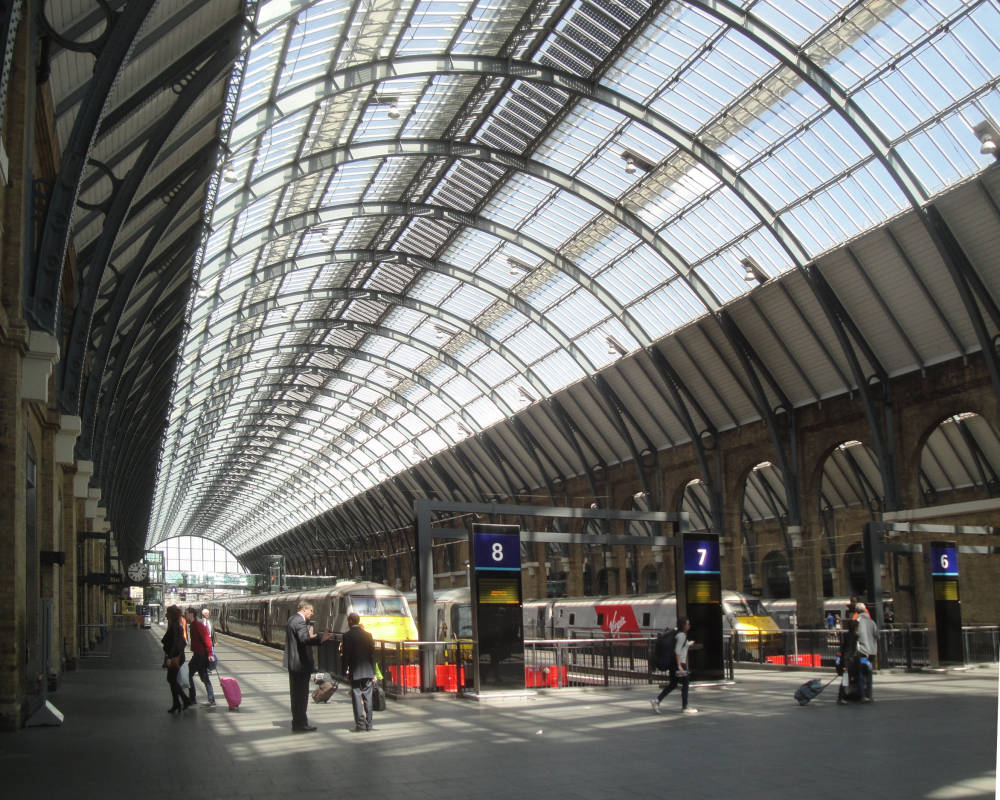
The London terminus of the Great Northern Railway was completed when the GNR reached Doncaster. Services were later extended to Bradford, Cambridge, Halifax, Leeds, Manchester, Nottingham, and Sheffield. All the important Yorkshire manufacturing towns were eventually served by the GNR. During the ascendancy of the Modern Movement, King’s Cross was frequently cited as an example of proto-modernism and compared favourably with Euston’s classicism — “display” as Nikolaus Pevsner described it — and the brilliant, though misguided, mediaevalism of St. Pancras. John Betjeman captured prevailing attitudes in architectural circles towards King’s Cross in the 1930s: “ . . . we were all told to admire King’s Cross for its functional simplicity, an earnest of the new dawn. We were told to despise St Pancras for its fussiness though we were allowed to admire the engineer’s roof. All the same I have an idea that St Pancras is the more practical station.” (London’s Historic Railway Stations, 1972)
In his account of London in his Buildings of England, 1952, Pevsner wrote “
Cubitt, perhaps because he came from a family of builders and engineers, looked at his job with equal pride but no romanticism. [He was comparing King’s Cross with Hardwick’s Euston.] The two arched roofs . . . are frankly displayed as the predominant motif of the fa�ade . . . The roof of the clock tower heralds the coming of the new Italian villa ideals. Otherwise one does not look for �motifs’ at King’s Cross. The architect was satisfied to depend, as The Builder put it in 1851, ‘on the largeness of some of the features, the fitness of the structure for its purpose, and a characteristic expression of that purpose’
It is worth pointing out that the Italianate features of King’s Cross — notably the tower as cited by Pevsner — could well reflected Prince Albert’s enthusiasm for Karl Friedrich Schinkel’s Italianate designs for the Prussian royal family — notably his work at Charlottenhof. Albert, incidentally, had chosen Lewis’ alder brother Thomas as his architect for Osborne House (1845-48), the summer home of the royal family on the Isle of Wight. Thomas Cubitt (1788-1855), who had begun his career as a carpenter, was the greatest London speculative builder and developer of the 1820s. Belgravia, Bloomsbury, Pimlico and Tyburn were largely built by him and he made an immense fortune. Lewis Cubitt also built the Great Northern Hotel (1854) — the oldest hotel in central London — which adjoins King’s Cross. Unlike the station, it is of no remarkable architectural distinction, though the passing years have given it a charming patina. It is recommended for those wishing to spend a night in London before going on to Luton Airport. When King’s Cross is restored the space between King’s Cross and St Pancras International will form a magnificent piazza. The two stations will supply a vivid lesson in the polarities of nineteenth-century architecture. (Lewis Cubitt was a very successful bridge designer — much of his work was overseas. He deserves more attention than he has received from historians.)
Paddington Station, London (1854), designed by Isambard Kingdom Brunel (1806-59) Matthew Digby Wyatt (1820-77) and Owen Jones (1809-74)

Christopher Wren’s son inscribed upon his father’s tomb in St Paul’s “Lector, si monumentum requiris, circumspice,” [“Reader, if you seek his monument, look about you”]. The Great Western Railway is Brunel’s monument. A railway is infinitely complex — calling for prowess in both civil and mechanical engineering, to say nothing of artistry. And Brunel had the imagination of an artist. He was responsible for building over a thousand miles of track. The gauge of his track was 7-foot-and-a-quarter inch. As trains could be more stable than with a narrower gauge, high speeds could be attained — speeds of 60 mph were commonplace, locomotives were more powerful,; since they had bigger boilers, railway carriages could accommodate more passengers in greater comfort, freight trains could carry more . . . For all its advantages, the broad gauge was not adopted nationally. The last broad gauge train ran on May 22nd 1892. The proudly independent Great Western had finally to conform to the standard gauge used by the other railways — 4-feet 8-and-a-half inches.
The designer of Brunel’s locomotives was Daniel Gooch (1816-89), who is, for many, the greatest locomotive designer of the century. Then there were Brunel’s ships — the SS Great Western (1837), the SS Great Britain (1843) — the first screw propelled ship to cross the Atlantic — and the Great Eastern, it had a length of just over 207 metres and a breadth of just over 25 metres. The Great Eastern could reach a speed of almost 20 miles an hour. Here is Brunel writing to Matthew Digby Wyatt on Paddington — months before the completion of Paxton’s Crystal Palace , which housed the Great Exhibition of 1851.
I am going to design, in a great hurry, a station after my own fancy . . . with engineering roofs etc., etc.. It is at Paddington, in a cutting, and admitting of no exterior, all interior and all roofed in . . . Now such a thing will be entirely metal as to all the general forms, arrangements and design; it almost of necessity becomes an Engineering Work, but, to be honest, even if it were not, it is a branch of architecture of which I am fond, and, of course, believe myself to be fully competent for, but for detail of ornamentation I neither have time nor knowledge, and with all my confidence in my own ability I have never any objection to advice and assistance even in the department which I keep to myself, namely the general design. Now, in this building which, entre nous, will be one of the largest of its class, I want to carry out, strictly and fully, all those correct notions of the use of metal which I believe you and I share (except that I should carry them sill farther than you) . . . I want to show the public that colour can be used . . . ” (quoted also by L T C Rolt, Isambard Kingdom Brunel, London, 1957.)
The colour scheme of Paddington — long since vanished — was by the architect, historian and theoretician, Owen Jones, who was responsible for the colouring of Paxton’s Crystal Palace. Jones, whose stature has yet to be fully recognised, was as progressive as Brunel. He moved in advanced intellectual circles and was a close friend of the novelist George Eliot (Marian Evans, 1819-80) and her consort George Henry Lewes (1817-78), the writer and biographer of Goethe. Matthew Digby Wyatt was a successful architect — Secretary of the Great Exhibition and Surveyor of the East India Company. He was also, in an era when art history was an emerging discipline, the first Slade Professor of Fine Art at Cambridge. Like Owen Jones he was an accomplished designer and, indeed closely associated with Jones. It is not difficult to detect the influence of Jones in the Moorish cast-iron capitals at Paddington. Jones’ first great publication — the monumental two volume Alhambra, London, 1836-45, being the inspiration.

The Railway Station, by William Powell Frith (1819-1909)
Brunel had a copy of the book — the early plates are the first to be printed in colour in Britain. The Railway Station, by William Powell Frith (1819-1909) depicts a crowded arrival platform at Paddington in 1862 — the painting is justly famous for depicting the many layers of Victorian society. Frith’s depiction of the station and one of Gooch’s splendid 4-2-2 locomotives is commendably accurate. (In 1953 Sergei Kadleigh (d.1972) put forward detailed proposals for a high rise scheme — a “town of eight thousand people” to be built over the goods yard adjoining Paddington Station. “High Paddington” was a megalomaniac scheme, inspired no doubt by Le Corbusier’s Ville radieuse. It would have dominated West London.)
New Street Station, Birmingham (1854) designed by Edward Alfred Cowper (1819-93)
New Street has always been the busiest of provincial British stations. Cowper’s station was entirely re-built by British Railways in the mid 1960s when the West Coast Main Line was electrified. It is a bland, efficient station of no substantial architectural interest. At 211 feet (64.31m.) Cowper’s original wrought iron and glass roof had the largest single span anywhere — until it was surpassed by Barlow’s and Ordish’s St Pancras train shed at 243 feet (74.07m.) completed in 1867. New Street was constructed by Messrs. Fox, Henderson & Co. for whom Cowper had worked — he had been responsible for the company’s contract drawings for Joseph Paxton’s 1851 Crystal Palace. George Gilbert Scott praised New Street in Secular and Domestic Architecture (1857): “An iron roof in its most normal condition is too spider-like a structure to be handsome, but with a very little attention this defect is obviated. The most wonderful specimen, probably, is that at the great Birmingham Station . . . ” Cowper was among the leading figures from what L T C Rolt described as a “brief heroic age of engineering”. He was the son of a professor of engineering at King’s College, London. At fourteen he began a seven-year apprenticeship with John Braithwaite (1797-1870) — a successful civil engineer. While still an apprentice he devised a system of railway signalling by means of small detonators — which made a load bang when a train passed over them. These were widely used in fog to alert engine drivers of hazards — when conventional signals could not be seen. Cowper set up on his own account as a consulting engineer in 1851. He contributed much to the development of steam technology. In 1870 he invented a device by which hand-written messages could be transmitted by telegraph without the need for the use of Morse code. Cowper was consulting engineer to the Post Office.
St Pancras, London (1865-68)
Designed by William Barlow (1812-1902) and Rowland Mason Ordish (1824-86) — Midland Hotel by George Gilbert Scott (1811-78)



For the last ninety years almost, Sir Gilbert Scott has had a bad press. He is condemned as facile. Smart, aggressive, complacent and commercial. When at the top of his form Scott was as good as the best of his Gothic contemporaries. He was so firm a believer in the Gothic style as the only true ‘Christian’ style — Scott was a moderate High Churchman — that he was determined to adapt it for domestic purposes. St Pancras Station hotel was his greatest chance in London and well he rose to the occasion. I used to think that Scott was a rather dull architect, but the more I have looked at his work the more I have seen his merits. — John Betjeman and John Gay, London’s historic railway stations, London, 1972



With its castellated fringes, scores of dormer windows (each with its finial), its myriad pointed-arch windows below the cornice . . . the Midland Grand Hotel was one of the finest and largest examples of Victorian secular Gothic. From the elaborate porte coch�re at the west-end, at the west end, the 565 ft frontage curved back and round to parallel the Euston Road, terminating in a 270 ft spire-capped clock tower which was a worthy rival to that of Barry and Pugin at Westminster. — Alan A Jackson, London’s termini, Newton Abbot, 1969
Liverpool Street, London (1871-75) designed by Edward Wilson — Chief Engineer of the Great Eastern Railway

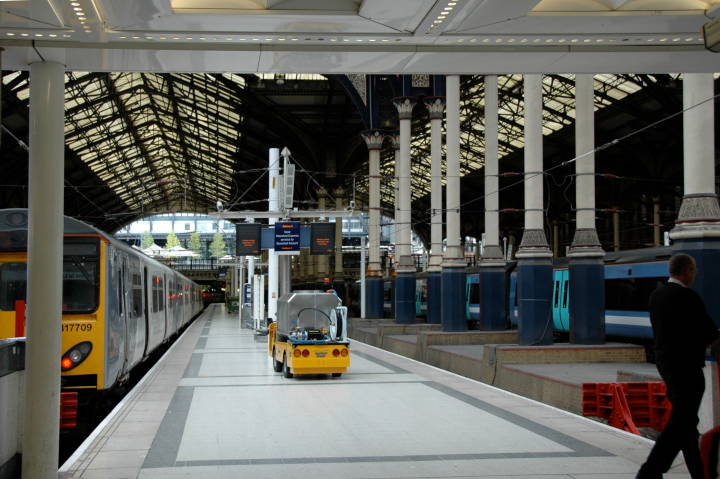
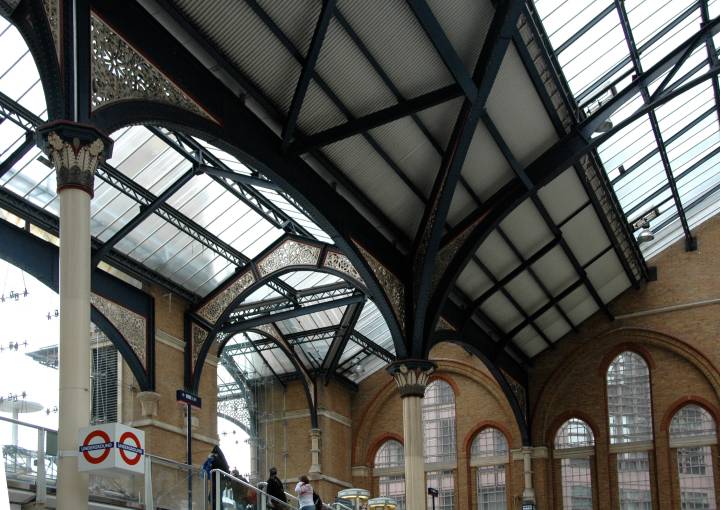
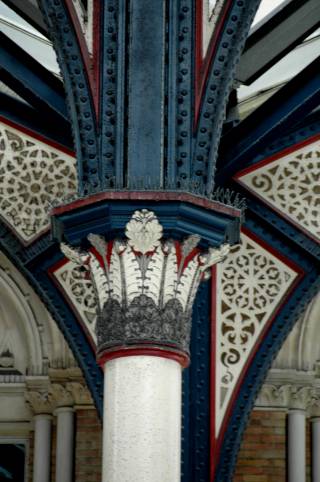
The first London terminus of the Great Eastern Railway was at Shoreditch. Liverpool Street was created in order to bring the railway closer into the City. A substantial part of the station’s traffic consisted of working-class commuters who came from London’s northern suburbs. In addition, Liverpool Street served East Anglia — and Harwich which was growing steadily in importance as a port. The site had been once occupied by Bethlem Hospital, where people once paid to enjoy gawping at and teasing the insane. Liverpool Street takes its name after Lord Liverpool (1770-1828), the longest serving British Prime Minister. The cost of the site was considered to have been excessive at the time. And there are still the steep gradients — always to be avoided in railway construction — leading up to the station. Liverpool Street perhaps lacked the architectural charisma of the old Euston, St Pancras, or Brunel’s Paddington. For all that, its ironwork, with its filigree cast iron brackets and sturdy capitals — now painted in very congenial colours — is a delight. The 1994 metamorphosis of the station by Nick Derbyshire and his team — which involved the replicating of Victorian wrought and cast iron — has given new energy to the once dowdy station. Circulation in the station which was once notoriously difficult to navigate has also been vastly improved. The present Liverpool Street station affirms the value of refurbishing a perfectly serviceable nineteenth structure. The Great Eastern Hotel, by Charles Barry, junior (1823-1900), the son of the architect of the Houses of Parliament, has been transformed into a boutique hotel by Conran & Partners.
The Victoria Terminus (now Mumbai Chhatrapati Sivaji Terminus, 1888)
Designed by Frederick William Stevens (1847-1900)

The station was named the Victoria Terminus on the occasion of Queen Victoria’s Jubilee in 1887. In 1996 it was renamed the Chhatrapati Shivaji Terminus in honour of Chhatrapati Shivaji (1627-80), scourge of the Mughals and founder of the Mahratta empire, which was finally extinguished by the British in the early nineteenth century. Mumbai is the capital of Maharashtra and Shivaji is the state hero. The station — the original terminus of the Central Railways — was designed by Frederick William Stevens, born in Bath, who joined the Indian Public Works Department at the age of twenty. It is said to have been influenced by George Gilbert Scott’s Gothic Midland Hotel, although it incorporates fine Indian carving and decorative features. John Lockwood Kipling (1837-1911), father of Rudyard Kipling, was Director of the Sir Jamsetjee Jeejebhoy School of Art in Bombay — the first modern art school in India. The institution promulgated the idea of amalgamating Indian and Western traditions, which was part of government policy. The Chhatrapati Shivaji Terminus was put on the UNESCO World Heritage List in 2004 — the first building of its kind.
Waterloo, London (1922) , designed by James Robb Scott
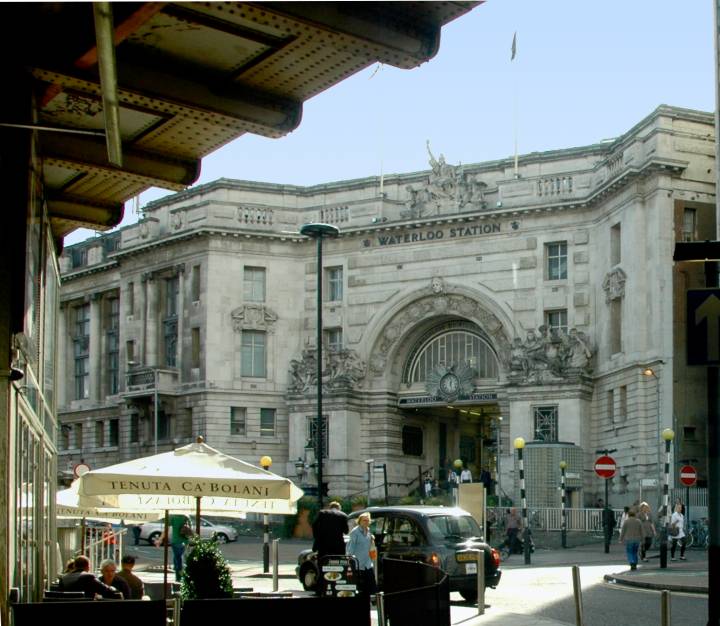

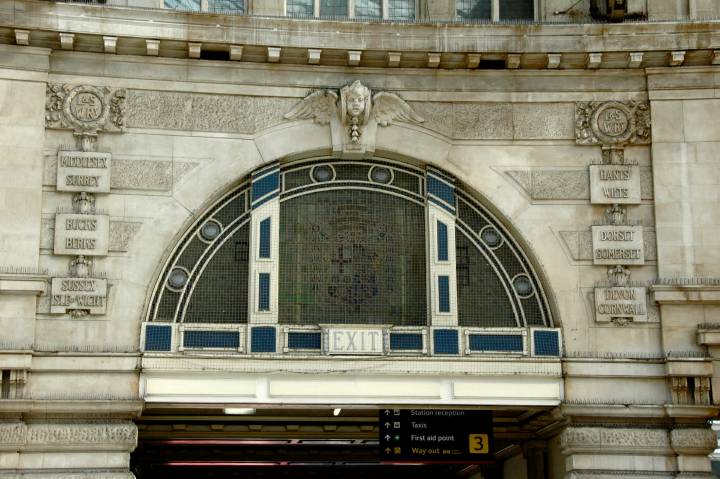
The busiest British station. The first London and South Western Railway’s London terminus was at Nine Elms and opened on 21st May 1838. It was a modest neo-classical structure designed by Sir William Tite (1798-1873). It was his first station. He had no inhibitions about style and Gilbert Scott admired some of his bold vernacular stations in the North. Steam riverboats took passengers from Nine Elms to London Bridge and other points on the North bank of the Thames. This arrangement caused fairly considerable inconvenience to passengers. Waterloo Station was opened in 1848 — with two train sheds of 100 feet (30.48 meter) spans. The LSWR’s traffic passenger traffic increased exponentially as Waterloo served Portsmouth — and latterly Devonport (1876) — the great naval bases as well as Aldershot, the principal army base. There was also the huge increase in commuter traffic from Kingston, Surbiton and Richmond. By 1892, Waterloo was handling 50000 passengers a day. The LSWR had, incidentally, extended its services to Exeter in 1860 and, by 1899, Padstow in Cornwall.
The station became noted for the difficulties passengers experienced in finding their correct departure platforms. There is a story — no doubt apocryphal — of a Devon farmer who declared to his wife “no wonder the French were defeated at Waterloo”. At the turn of the century the LSWR Board decided that Waterloo needed to be rebuilt and J W Jacomb-Hood, LSWR’s Chief Engineer, was sent to the United States to study contemporary station design. He was to be responsible for the structure and planning of the present station — although certain bays from the earlier station were retained. After the death of Jacomb-Hood in 1914, A W Szlumper took over. James Robb Scott, “Chief Architectural Assistant of the LSWR” was to be responsible for the architecture of the station. Nikolaus Pevsner in his Buildings of England. London, first published in 1952, had little time for Waterloo. Its steelwork was “sadly timid” and Robb Scott’s fa�ade was “spoiled by a hopeless position”. Indeed, the location of Waterloo has always been to its disadvantage — and, furthermore, it is the only great London station south of the river. Scott’s architecture is, for the most part innocuously late Edwardian. However, his triumphal arch is a splendid example of the style that has been described as “Imperial Baroque”.
Sir Aston Webb (1849-1930) — designer of the Admiralty Arch of 1911, which commemorated the life of Queen Victoria, was the supreme exponent of the style. Pathetically ill-sited — but where else could it have been placed? — Scott’s arch commemorates the victory of the First World War. The names of LSWR employees killed in the war are recorded on plaques on the side of the steps, as are those of the Southern Railway killed in the Second World War. There are monumental statues of Bellona, the Goddess of War, and Peace flanking the steps. The arch is surmounted by a triumphant Britannia. Attached to the station — and sharing the concourse — is Waterloo International Terminal by Nicholas Grimshaw and Partners, which was opened in 1993. The design has been much admired. It has been said that it owes a little to Dutert’s and Contamin’s three-hinged Palais des Machines, at the Exposition Universelle, Paris 1889. The International Terminal will cease operation when the new St Pancras opens, although it will continue to be used for ordinary train services. Waterloo, despite its architectural failings — in particular its vainglorious attempt at monumentality — is a pleasant and efficient station. For all the lack of bravura of the scheme, the glazed roofs of Jacomb-Hood and Szlumper give Waterloo some of the best natural lighting of any station.
Last modified 3 July 2016